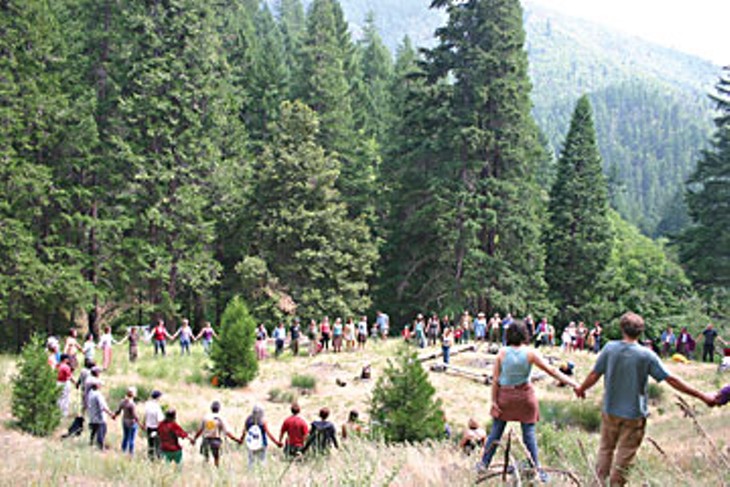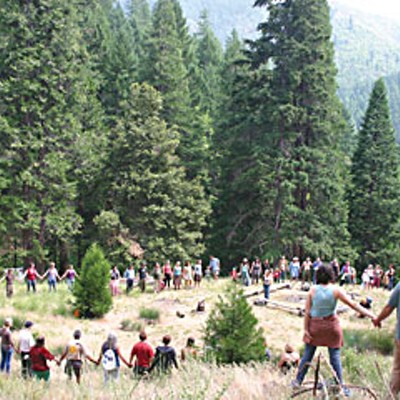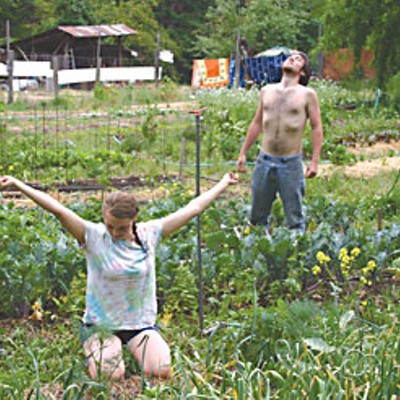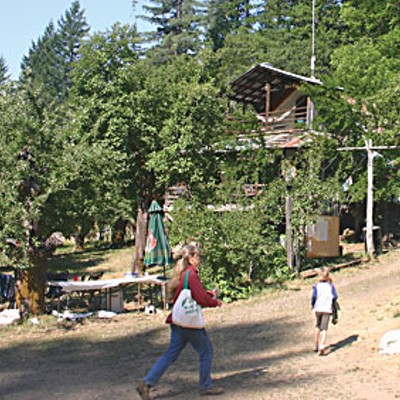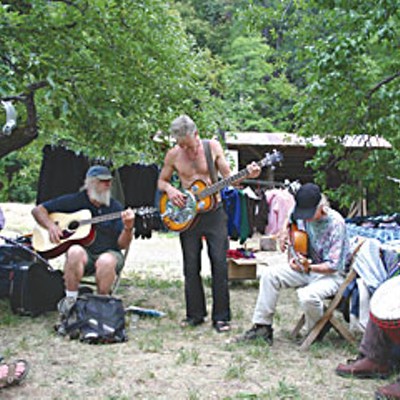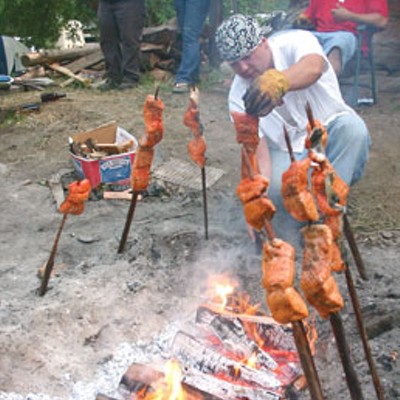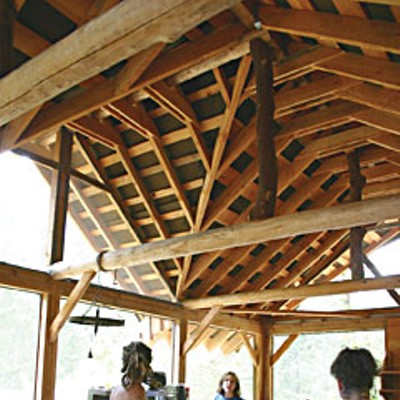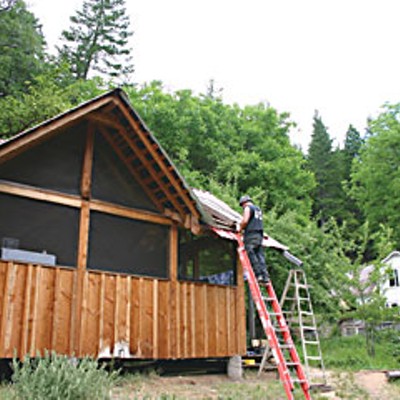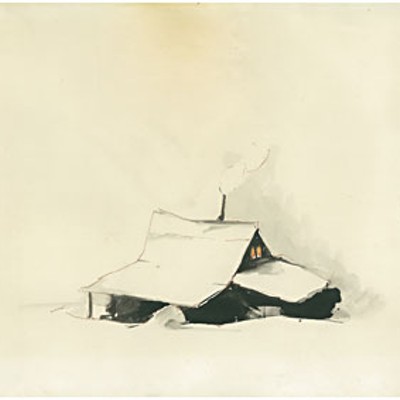[
{
"name": "Top Stories Video Pair",
"insertPoint": "7",
"component": "17087298",
"parentWrapperClass": "fdn-ads-inline-content-block",
"requiredCountToDisplay": "1"
}
]
We had celebrated the seasonal holidays, the equinoxes and the solstices, from the time we started the Black Bear Ranch Commune in 1968. I thought about those early days as we navigated the tangle of log roads leading into Black Bear for what would be the 40th summer solstice this June. A couple hundred people were expected and it was hard not to dwell a little in the past. Salmon River country is forests, and steep terrain. It’s that way where I live these days, down near the bottom of the river, and it’s even more that way up at the commune. Even the dust and the bumps seemed familiar.
There were many communes in the ’60s, some spiritual, some with a wealthy sponsor. Black Bear was not against spiritual and we would have loved a wealthy sponsor. Most Black Bear people were Sixties-political and they were willing to live in the middle of northern nowhere. And there are still people living there collectively today.
The first big celebration at the commune was the autumn equinox in 1969. Thirty of us had survived the first intense Siskiyou County winter and were swollen with rural bravado. We invited up all the extended family from the Bay Area and beyond. One day Richard Marley, who I always thought of as the founder of Black Bear, had called us together to plan for the expected onslaught of visitors. What preparations would be needed? We talked passionately, if inconclusively, around the circle for an hour or more and finally agreed that things would take care of themselves. No planning necessary. People used to think that way in the ’60s.
In some ways things did care for themselves at that first big celebration. The San Francisco Diggers by the score appeared in trucks and buses and gypsy wagons. They knew that hospitality was a two-way street and brought enough food, not just for the Equinox celebration, but also to carry us isolated Black Bears through the entire winter. By then everybody had heard that we’d been snowed in most of the previous winter — an epic like the Donner Party except with vegans playing all the parts.
Others came, too. Anarchists from Lower East Side New York via New Mexico. I think a few of the Black Maoists from the East Bay, with their golf bags full of rifles and shotguns. A handful of Hells Angels in a Chrysler convertible.
My favorite was Willis Conrad, a traditional dip-net fisherman from the Karuk Tribe and the first of the river area locals to befriend the commune. Willis arrived in a weathered pickup with gunny sacks full of fall-run salmon, just caught at Ishi Pishi Falls in Somes Bar.
Hundreds showed for that 1969 Equinox. There was food aplenty. But their vehicles broke down. Sanitation, which we then considered a bourgeois conceit, broke down too and there was an outbreak of Shigella, a dysentery. The mechanics struggled to find or order parts for the stranded vehicles. Finally, by the time the winter rains were starting, the last of the guests were gone. The vast store they had brought of winter provisions was mostly eaten and we began to get letters from the state department of health about our drinking water. It had been a great party.
So this time the current communards and a few alumni did some serious planning. New water filters. Provisional privies. Signs and parking areas. Supplies and cooking arrangements. Newcomer reception table. Traffic control and fire protection. Projects and workshops.
There were long discussions of whether visitors’ dogs would spook the new cow and whether drunk celebrants would spook most everybody. No new rules there. Anarchists are good at lots of things but making rules isn’t one of them.
In the annals of people who founded great, enduring communities, I would not have expected to find Richard Marley, but here was Black Bear with a new crowd of residents and still going strong 40 years later. Marley came to the mountains from San Francisco in 1968 with the 30 hippies who were ready to be talked into anything. I guess I was one of them. Richard came into one of the big Digger houses in Haight Ashbury, a place where Diggers distributed free food, free clothes and free lots of other stuff, and sold us on the idea. By the second year there were 60 of us.
Richard was a longshoreman, a committed Marxist and the sweetest streetwise hustler I’d ever met. I tried to imagine what he would have thought if he were still with us for the 40th summer solstice. He’d probably say, “Have some rituals but not too many and have way too much food.” Richard came to Black Bear with a seasoned cynicism that was the first stage of wisdom.
It was fitting then, as I pulled down into Black Bear Ranch — in what passes for clear, flat land in steep, wooded Salmon River country — that the first person I ran into was Richard’s widow, Elsa. She was standing between a tall, decrepit barn and a lush fenced garden. Elsa is an art teacher at San Francisco City College nowadays and an accomplished artist blending Chinese and Western styles. Age has her carrying a cane, but she moves undaunted.
“Malcolm,” she gushed. “People just had a meeting that was exactly like the meetings we used to have. Could people play basketball against the barn if the new cow was pregnant? Was the cow even pregnant? After 20 minutes, it turned out there wasn’t any basketball anyway so they turned to the next topic. It was exactly like us.”
We stepped off the road as a string of vehicles pulled past the barn to the Mainhouse to unload crates and sacks of food, musical instruments and camping gear. The isolated little flat along Black Bear Creek where I’d pitched my tent quickly became a tent city.
That first afternoon about 100 people arrived. There were former Black Bears I knew and many other people who lived in nearby river towns or from places as far as Portland or the Bay Area.
Ben Riggan, now a forest activist in Orleans, told me he’d lived at the ranch from 1993 to 1995. During that time the population of the commune had gotten very small. An influx finally came after the death of Jerry Garcia, when a small handful of Deadheads gave up the road life for the commune in the mountains.
He pointed over toward a weathered old-timer and said, “Clarence Hagmeier taught me homesteading skills.”
Clarence said he had lived at the Ranch through the 1990s and saw many fluctuations. The people then were “sometimes far out; sometimes not so far out,” Clarence said, falling back on 1960s vernacular.
“There were spikes in the Mainhouse kitchen to hang a deer or a goat after butchering,” he said. “Some vegetarian who just moved to the Ranch two days earlier would tell me I couldn’t do it.” (Richard Marley, in the dead of one of those long winters, had lamented, “I feel like I’ve been kidnapped by a tribe of vegetarians and raised as one of their own. They treat me well enough, I guess.”)
Part of that Deadhead diaspora was Jaya Krupp, now the owner of Balance Fitness Studio in Old Town Eureka. Black Bears invited her and a few others to the Ranch at a Rainbow Gathering in 1995. “It’s interesting to be here,” she said, lingering in the teeming Mainhouse kitchen with the largest wood-fired stove any of us had ever seen.
“The smells are the same. This place is so saturated with history and with room to make more. I learned to cook on that wood stove and it gave me the feeling I could do anything.”
The Mainhouse is a relic the commune inherited from over a century ago when Black Bear Ranch was one of the more prosperous gold mines in California. John Daggett, the mine owner, even propelled himself into politics as the state’s lieutenant governor.
As more and more visitors filtered down to Daggett’s old house, cooks were hurrying, dishwashers were scrubbing and a zillion other people were hugging, handshaking and storytelling.
Into this hubbub, Geba Greenberg began trying to convene a circle on the front lawn. Those people who whine about herding cats have never tried to herd hippies, but Geba, who came to the Ranch in 1970 and stayed 18 years, is not a woman easily discouraged.
Finally there was a movement toward the circle and a huge conch was blown. Like Geba, the deep roar of a conch well blown is a signal not easily ignored.
The circle was large and attentive. There were words of welcome and announcements of the different activities going on, what would be called break-out sessions in a corporate setting.
For starters, there would be a body training in prep for a ritual on the knoll. (When I’d channeled Richard Marley, he’d warned me.) Also, a writing workshop in the Casbah, an ad hoc canopy with cushions and curtains set up next to the barn. Painting after the writing. A 2 p.m. parade to the knoll and a storytelling circle.
A tall, bearded man announced that there would be a community weed (pause, while he searched for the right word) discussion on the lawn at 4:20 p.m.
Crew formation was promoted for wood cutting, bridge repair, cooking and kitchen cleanup. Black Bear has always seemed an interplay between the hard work it takes to survive in the mountains and the productive sloth it takes to recover from city living.
Osha Neumann, who became a lawyer for poor people in the East Bay after leaving Black Bear, relayed an update about a long ago Bear from my era. She was again having setbacks from cancer. Then Geba, in the style of the old days, began a song-chant, maybe one from the Black Bear sweat lodge:
Round and round we go. We hold each other’s hands. Weave our lives in a circle. The love is strong. The dance goes on...
Others knew her song and soon much of the circle joined her.
The next sounding of the conch would announce dinner, we were told, and the herd began to mill again.
Then, out of nowhere appeared Indira Star, Richard and Elsa’s daughter. Indira was 6 months old when we started the commune and she still has the exuberance of a bubbly kid. She said, “I remember you standing right there, Malcolm, and teaching me how to walk.” She mimicked me standing there with outstretched arms.
“You were barely a year old,” I said. “How can you remember something from so long ago?”
“I remember lots of early stuff,” she said. “I remember walking from the dome to the Mainhouse when the path was like a canal in the snow. Could it really have been three feet deep?” (It was.)
“I remember a huge fight. The grownups, they were fighting over some woman, rolling around on the ground.”
Milgra Tyler, who was born on the Ranch in 1970, said she remembered the fight, too, maybe because it was so out of the ordinary. “I also remember going from lap to lap. There was always some grownup who had your back. We were allowed to walk up the six-mile trail from Indian Creek with another kid. We had this huge freedom. Where I live now in Eugene, we don’t let our kids go a half block.”
Outside, the summer weather began to shift. A light rain shower fell on a handful of visiting college students weeding in the Mainhouse garden and they celebrated as the rain washed away a swarm of mosquitoes and no-see-ums. That night, the campers were awakened by a huge thunderstorm. Lightning seemed continuous and close.
The next morning, the early risers clustered around the summer kitchen, a well-built screen room designed for canning fruit but easily converted into a coffee shop. The first traces of drift smoke moved across the sky and the river residents knew that meant lightning fires somewhere along the Salmon River.
Ben Beaver, who’d moved to the Ranch as an infant and lived there 12 years, said that he’d found the location of the fires on-line and there were many of them across the state. Ben spent years on a hot shot fire crew and even the elders acceded to his expertise. It was partly because of the intense training given hot shots and partly because he carried a quiet manner that invited respect. Many of the Black Bear kids grew up that way, no small surprise when I think of how frantic we, their parents, seemed in the ’60s.
It amazes me, also, that it is now possible to have electricity produced at Black Bear by a little spinning turbine near the Mainhouse. And how they have Internet captured by a satellite dish. The night before the batteries had gone low and the regular rancheros had been shutting off lights. I said the bearings sounded worn but we all agreed that diagnosis was a job for Bob-o Schultze. Bob-o had lived at the Ranch for years and then left to become one of the preeminent solar electricians in the whole bioregion.
When I finally connected with Bob-o on Day Two, he said he’d fixed things. “The gauge had burned up and it was running open circuit. I just fixed it with a quick wire splice and they’re back on the road.” He said that like it was as easy as making a grilled cheese on rye and then added, “You’re right about the bearings. It’s time. Wind Beaver is on it.” Wind is one of Ben’s brothers — another Black Bear kid grown into a gifted young adult.
As the sun crested the ridge, more coffee drinkers appeared and we saw the new arrivals. Many, young and old, were forest activists and community organizers for whom Black Bear was a magnet or even a birthplace. Susan Bowers from Hayfork, who’d helped us long ago in the herbicide wars, was brewing a cup of tea. Felice Pace from Klamath, a fierce and effective ally in the timber wars that followed, was serving people coffee.
George Perlingi, a skilled carpenter from Orleans, asked Felice for advice about the pending Orleans Community Fuels Reduction project, OCFR for short. Felice suggested it was a timber sale in sheep’s clothing and gave advice on how to influence the outcome.
Toz Soto, fisheries biologist with the Karuk Tribe, struck up a technical conversation with Felice. Toz was born at the ranch early on in a miner’s fuel shed remodeled into a lavish one-room cabin. At least I thought of it as lavish when I lived in it, although it seems a little dark and spare now. “We need to model pre-mining stream flows so we can develop the desired future condition,” Toz summarized. How did those Black Bear kids get so smart? Something in the water?
As Day Two progressed, the crowds more than doubled and there was general approval by the alumni of the current Ranch residents. “They built new privies and they even have hand washing setups,” one old timer noticed aloud.
“I hear they made people leave who weren’t productive,” said another.
“How did they do that? We always wanted to kick a few people out and never could,” was the reply.
Gradually the throngs moved up to the knoll. The path rises to a small flat that overlooks the creek, the Mainhouse and, in the distance, the towering Trinity Alps. Geba waved a smouldering sage bundle over people as they arrived and they drew into another even larger circle, like Druids outfitted from the REI catalogue.
“We’ve been here 40 years and we keep coming back,” she pronounced to the crowd. Cheers all around. People were sorted into rows and columns like a very big yoga class. Earlier Osha had invited me to join him in leading part of the big ritual. I mumbled evasively and Osha said, “I take that to be a yes.” Osha must be a great lawyer.
Nieves, Clarence’s daughter now in her 30s, began to lead the crowd in a salute to the four directions. When everyone faced the Trinities, Geba intoned, “South, our mother, warmth, passion, fire, love, creativity.” Other people spoke to the other directions.
My mind returned to the knoll of 40 years ago. There had been births there, winter bonfires with LSD, a great painted tipi with a peyote circle. If there were psychedelics here at the present solstice, they were not in evidence. But maybe they weren’t needed.
I listened to the voices ascend to the tops of the incense cedars and Douglas firs that surrounded the knoll. My cynicism softened and maybe Richard Marley, if he were watching, would have been won over, too.
There was more weaving around. More hugging. I saw Dana Rose Colegrove, a downriver Indian woman who had visited the Ranch before. She told me that she had brought a load of fresh Spring Chinook salmon from Weitchpec and Hoopa.
I told Dana that springers were my favorite food in the entire world and retold the stories about Willis Conrad bringing us fall salmon for that equinox back in 1969. She knew Willis and she flashed a reserved smile. “We’re going to cook them Indian style, on stakes around a bed of coals just below the Mainhouse,” she said. “Come on down.”
All I ate that day was spring Chinook and fresh-picked cherries. There was plenty of other food — good food, and plenty — but I had what I wanted. As I lurked around the fire pit waiting for the next round of salmon on stakes, two more cars pulled up and disgorged what seemed an endless stream of young Indians.
It was Florence Conrad, Willis’ widow, with a crowd of her grandchildren. As they mingled or headed over to the Black Bear sweat lodge, I saw that one of them, a tall, smiling teenager, wore a black T-shirt with the tall lettering, “Got Land?” On the back it said, “Thank an Indian.”
“Who gave you the T-shirt,” I asked the boy. “Grandma,” he said, and pointed to Florence, who, besides grandmothering, holds a seat on the Karuk Tribal Council.
“Florence,” I teased. “You’ve become a radical.”
“I’ve always been a radical,” she said with pride, and she gazed out over the crowd.
Near the end, I saw Richard Marley’s son Orion. I had been there the night when he was born up Marley Gulch. Okay, we named it that, but later we talked the mapmakers into officially listing it with that name.
Orion told me that he was soon headed back to Iraq in the Army, his third tour there, and I invited him and his new bride, Miko, to stay overnight with us downriver on the Salmon on their way home to Central California.
I cooked them as fancy a dinner as I could manage and avoided mentioning the war. Same at breakfast with yeasted pancakes smothered in maple syrup and raspberries from the garden.
Orion picked up the New York Times, just arrived, and the lead story was headlined:
DEALS WITH IRAQ ARE SET TO BRING OIL GIANTS BACK
He read the first several paragraphs and grumbled, “And I always told everybody that we didn’t go over there for oil.”
Miko, his new bride, said, “I told you that’s what it was for.”
“What did you think it was when you enlisted?” I asked.
“I thought it was to kill bad guys. I guess I was wrong.”
I decided to tease: “There’s a paragraph at the end where Exxon Mobil pays a special tribute to Orion Marley in thanks for his work to make this oil deal possible.”
“Me and the 22 buddies I lost over there,” Orion said quietly.
My eyes welled up and I passed around the pancakes for seconds.
Malcolm Terence is an editor, along with Susan Keese and Don Monkerud, ofFree Land, Free Love, Tales of a Wilderness Commune. He is a frequent contributor toCalifornia TeacherandEcoNews. Before he moved to the Black Bear commune in 1968, he was a newspaper writer in Los Angeles. For other insights into the late 1960s, he recommendsSleeping Where I Fallby Peter Coyote,Fugitive Daysby Bill Ayers and the documentary film about Black Bear titledCommune, directed by Jonathan Berman.
Comments (6)
Showing 1-6 of 6
more from the author
-
From Orleans to the Capitol
Spreading Good Fire
- Dec 2, 2021
-
'Given These Songs'
Native singers gather to thank Brian Tripp; he thanks them back
- Jun 17, 2021
-
Fighting Fire with Fire
A devastating wildfire season highlights the need for prescribed burns
- Nov 5, 2020
- More »
Latest in News
Readers also liked…
-
Through Mark Larson's Lens
A local photographer's favorite images of 2022 in Humboldt
- Jan 5, 2023
-
'To Celebrate Our Sovereignty'
Yurok Tribe to host gathering honoring 'ultimate river warrior' on the anniversary of the U.S. Supreme Court ruling that changed everything
- Jun 8, 2023
